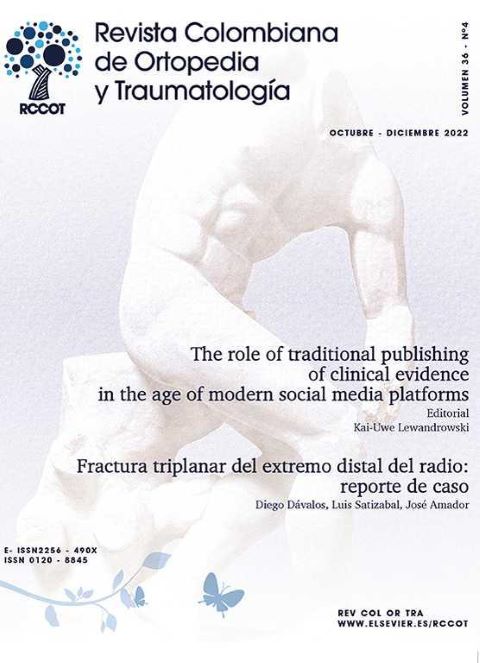Arthroscopic transosseous anchorless rotator cuff repair with enchondroma of the proximal humerus: A case report
DOI:
https://doi.org/10.1016/j.rccot.2022.07.002Keywords:
Rotator cuff, Chondroma, Humerus, ArthroscopyAbstract
A 55-year-old female consulted our service with chronic pain in her right shoulder
with no history of trauma. Shoulder X-rays and CT revealed an enchondroma in the proximal humerus without an associated fracture. The MRI also showed a complete rupture of the supraspinatus and infraspinatus tendons. Anchorless arthroscopic transosseous rotator cuff repair was performed. At 12-month follow-up, the patient regained functionality, and the enchondromatous lesion remained stable. Arthroscopic transosseous anchorless repair of a rotator cuff tear could represent a good surgical option for patients whose bone quality makes anchor placement inadequate.
Evidence level III: Leverl IV; case report.
Downloads
References
Lee DH, Hills JM, Jordanov MI, Jaffe KA. Common Tumors and Tumor-like Lesions of the Shoulder. J Am Acad Orthop Surg. 2019;27:236-45, http://dx.doi.org/10.5435/JAAOS-D-17-00449.
Hakim DN, Pelly T, Kulendran M, Caris JA. Benign tumours of the bone: A review. J Bone Oncol. 2015;4:37-41, http://dx.doi.org/10.1016/j.jbo.2015.02.001.
Mulligan ME. How to Diagnose Enchondroma, Bone Infarct, and Chondrosarcoma. Curr Probl Diagn Radiol. 2019;48:262-73, http://dx.doi.org/10.1067/j.cpradiol.2018.04.00248.
Levy JC, Temple HT, Mollabashy A, Sanders J, Kransdorf M. The Causes of Pain in Benign Solitary Enchondromas of the Proximal Humerus. Clin Orthop Relat Res. 2005;431:181-6, http://dx.doi.org/10.1097/01.blo.0000150114.19489.c4.
Donthineni R, Ofluoğlu O. Solitary enchondromas of long bones: pattern of referral and outcome. Acta Orthop Traumatol Turc. 2010;44:397-402, http://dx.doi.org/10.3944/AOTT.2010.2121.
Ellman H, Hanker G, Bayer M. Repair of the rotator cuff. Endresult study of factors influencing reconstruction. J Bone Joint Surg Am. 1986;68:1136-44. https://doi.org/10.2106/00004623-198668080-00002
McLaughlin HL. Lesions of the musculotendinous cuff of the shoulder. J Am Med Assoc. 1945;128:563, https://doi.org/10.1001/jama.1945.02860250009003
Randelli P, Stoppani CA, Zaolino C, Menon A, Randelli F, Cabitza P. Advantages of Arthroscopic Rotator Cuff Repair With a Transosseous Suture Technique: A Prospective Randomized Controlled Trial. Am J Sports Med. 2017 Jul;45:2000-9, http://dx.doi.org/10.1177/0363546517695789.
Wolf BR, Dunn WR, Wright RW. Indications for Repair of Full-Thickness Rotator Cuff Tears. Am J Sports Med. 2007;35:1007-16, http://dx.doi.org/10.1177/0363546506295079.
Yamaguchi K, Ball CM, Galatz LM. Arthroscopic rotator cuff repair: transition from mini-open to all-arthroscopic. Clin Orthop Relat Res. 2001:83-94. https://doi.org/10.1097/00003086-200109000-00011
Yamaguchi K, Levine WN, Marra G, Galatz LM, Klepps S, Flatow EL. Transitioning to arthroscopic rotator cuff repair: the pros and cons. Instr Course Lect. 2003;52:81-92. https://doi.org/10.2106/00004623-200301000-00022
Benson EC, MacDermid JC, Drosdowech DS, Athwal GS. The incidence of early metallic suture anchor pullout after arthroscopic rotator cuff repair. Arthroscopy. 2010;26:310-5, http://dx.doi.org/10.1016/j.arthro.2009.08.015.
Garofalo R, Castagna A, Borroni M, Krishnan SG. Arthroscopic transosseous (anchorless) rotator cuff repair. Knee Surg Sports Traumatol Arthrosc. 2012;20:1031-5, http://dx.doi.org/10.1007/s00167-011-1725-4.
Kuroda S, Ishige N, Mikasa M. Advantages of arthroscopic transosseous suture repair of the rotator cuff without the use of anchors. Clin Orthop Relat Res. 2013;471:3514-22. https://doi.org/10.1007/s11999-013-3148-7
Steinitz A, Buxbaumer P, Hackl M, Buess E. Arthroscopic Transosseous Anchorless Rotator Cuff Repair Using the X-Box Technique. Arthrosc Tech. 2019;8:e175-81, http://dx.doi.org/10.1016/j.eats.2018.10.004.
Chillemi C, Mantovani M, Osimani M, Castagna A. Arthroscopic transosseous rotator cuff repair: the eight-shape technique. Eur J Orthop Surg Traumatol. 2017;27:399-404, http://dx.doi.org/10.1007/s00590-017-1906-z.
Plancher KD. CORR Insights®: Anchorless Arthroscopic Transosseous and Anchored Arthroscopic Transosseous Equivalent Rotator Cuff Repair Show No Differences in Structural Integrity or Patient-reported Outcomes in a Matched Cohort. Clin Orthop Relat Res. 2020;478:1304-6, http://dx.doi.org/10.1097/CORR.0000000000001253.
Hong ED, Carrino JA, Weber KL, Fayad LM. Prevalence of shoulder enchondromas on routine MR imaging. Clin Imaging. 2011;35:378-84, http://dx.doi.org/10.1016/j.clinimag.2010.10.012.
Flanagin BA, Garofalo R, Lo EY, Feher L, Castagna A, Qin H, Krishnan SG. Midterm clinical outcomes following arthroscopic transosseous rotator cuff repair. Int J Shoulder Surg. 2016;10:3-9, http://dx.doi.org/10.4103/0973-6042.174511.
Black EM, Lin A, Srikumaran U, Jain N, Freehill MT. Arthroscopic transosseous rotator cuff repair: technical note, outcomes, and complications. Orthopedics. 2015;38:e352-8, http://dx.doi.org/10.3928/01477447-20150504-50.
Morse K, Davis AD, Afra R, Kaye EK, Schepsis A, Voloshin I. Arthroscopic versus mini-open rotator cuff repair: a comprehensive review and meta-analysis. Am J Sports Med. 2008;36:1824-8, http://dx.doi.org/10.1177/0363546508322903.
Liem D, Bartl C, Lichtenberg S, Magosch P, Habermeyer P. Clinical outcome and tendon integrity of arthroscopic versus mini-open supraspinatus tendon repair: a magnetic resonance imaging-controlled matched-pair analysis. Arthroscopy. 2007;23:514-21, http://dx.doi.org/10.1016/j.arthro.2006.12.028.
Zarezadeh A, Dehghani M, Mohammadsharifi G, Omidian A. A Comparison of the Clinical Outcomes between Arthroscopic and Open Rotator Cuff Repair in Patients with Rotator Cuff Tear: A Nonrandomized Clinical Trial. Adv Biomed Res. 2020;9:13, http://dx.doi.org/10.4103/abr.abr 226 19.
Tingart MJ, Apreleva M, Lehtinen J, Zurakowski D, Warner JJ. Anchor design and bone mineral density affect the pull-out strength of suture anchors in rotator cuff repair: which anchors are best to use in patients with low bone quality? Am J Sports Med. 2004;32:1466-73, http://dx.doi.org/10.1177/0363546503262644.





